Besides being a slow swimmer, it is also an excellent hunter that will munch small animals when they come it’s way. Fish belonging to this species are solitary and can survive comfortably alone in a tank. If you need to keep it with other tank mates, it is best to keep it with other fish that are aggressive because any docile fish will find it rough with the Dwarf fish.
These fish are commonly available and relatively cheap. The major consideration with keeping a Dwarf lionfish is often they are not trained to eat prepared foods at the time of purchase. As a result, the hobbyist has to provide live foods until the fish starts eating prepared foods. However, they are really easy to care for once you understand their needs. They come in a variety of colors and are all fun to watch.
Table of Contents
Dwarf Lionfish Overview
The Indo-Pacific area, which constitutes eastern Africa, the Red Sera, Tonga, and Samoa, houses the Dwarf Lionfish. The Mariana Islands, Southern Japan, Lord Howe Island, and Australia are all native homes of the Dwarf. They’re nocturnal, which means they tend to hunt at nighttime and rest during the day on a shallow reef just several meters offshore.
Weed-covered rocks, Ref flats, and shallow lagoons are easily replicated in a marine tank set. Please remember that Dwarf Lionfish requires plenty of swimming room, both in and out of the water.
| Information Chart | Dwarf Lionfish |
|---|---|
| Scientific Name: | Dendrochirus brachypterus |
| Family: | scorpionfish |
| Care Level: | Intermediate |
| Temperament: | Semi-aggressive |
| Color: | brown to red |
| Lifespan: | 10 years |
| Size: | 6-7 inches |
| Diet: | Carnivore |
| Minimum Tank Size: | 50 gallons |
| Temperature: | 22.7 to 28.8 degrees Celsius |
| Water Conditions: | optimal water quality |
| Tank Mate Compatibility | Will hunt down smaller fish |
Dwarf Lionfish Appearance
The Dwarf Lionfish’s pectoral fins are one of its most striking features. They are always bright in contrast with their varying body colors, i.e., brown and red. Their large pectoral fins are distracting and help them attain smooth self-movement.

When the lionfish sets out to hunt, it employs its moveable pectoral fins to execute various activities, including moving them forward and side-to-side. This ‘dancing’ performance confuses its victims and allows the lionfish to consume its prey entirely in seconds. In the instance of dwarf fuzzy lionfish, the fin movements are significantly more exaggerated. They twitch in a back-and-forth motion, which highlights their body movements.
The actual color of the Dwarf Lionfish depends on its geographic region. However, the most common colors are yellow, red, silver, and black. These vibrant colors are most prominent in fishes in the pet store. In addition, they have leafy appendages on the lateral line, the head, and a short tentacle over the eye.
Dwarf Lionfish seldom grow bigger than 6 inches, making them ideal for aquariums with smaller spaces. Although they are often confused with Zebra Lionfish due to their size, there are a few notable differences. Dwarf Lionfish are less than half the size of Zebra Lionfish. Additionally, dwarf lionfish have bands on their pectoral fins.
The fish exhibits a beautifully striped-scale structured body with amazing fins and frills. It appears somewhat indistinct to other larger fishes that prey on it due to its small size. It usually grows up to 15cm in length in the wild.
As for coloration, the fish comes in various colors based on geographic location. Some of the most exclusive colors this fish exhibits include; Morphy’s deep red color, rare silver color with striking yellow dorsal and pectoral fin.
However, you should not expect striking colored fish from pet shops.
Types Of Dwarf Lionfish
1. Dendrochirus biocellatus (Fu Man Chu Lionfish) – This variant has bright red and orange colors with black patches and uneven patterns. They differ by two huge whiskers that are unique to this species. Their pectoral fins resemble Spanish fans.
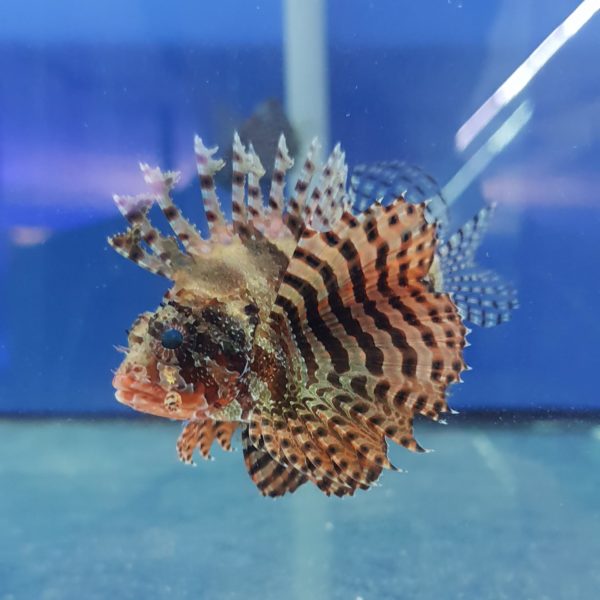
2. Dwarf Fuzzy Lionfish – The fish is found in green, brown, red, and yellow colors. It is an exceptional pet because of its ability to recognize its owner’s presence and even wait for the owner to nourish it.
3. Hawaiian Lionfish– This green species is well-known for its beauty. Divers have given them the moniker Green Lionfish because of their coloring.
4. Dendrochirus zebra (Zebra Turkeyfish)– This little fish has speckled patterns all over its body. They, like their kin, hide in caves and rocky areas.
The Lifespan Of Dwarf Lionfish
The typical lifespan of a Dwarf Lionfish is 10 years.
Dwarf Lionfish Size
The Dwarf Lionfish grows up to 6 inches on the lower end and 7 inches for larger specimens.
Its size is what makes them suitable for smaller saltwater aquariums. And they’re comparatively easier to handle than larger varieties such as the Volitan Lionfish, which can grow to be over a foot tall in no time.
Natural Habitat And Origin
The Dwarf Lionfish is known to inhabit brackish water, which led it to spread into non-native areas, like the Caribbean waters, termed an invasive species. Naturally, the fish inhabits shallow coastal areas featuring reed-encrusted rocky outcrops where it stays in hiding to waylay unsuspecting crustaceans.
These fish have an attractive fuzzy appearance with a one-of-a-kind scale morphology and striking patterns used to camouflage when hunting.
It is a native of the Red Sea, part of the Indo-Pacific region, though it has spread to the Atlantic Ocean. The invasion has spread so far that they are now found in invaded waters rather than their natural habitat. Their current range includes the Caribbean Sea, Arafura Sea, Tonga, Samoa, Mariana Islands, and Japan.
Saltwater fishes are found in shallow seas with rocky bottoms, lagoons, and muddy environments. They prefer to live in crevices and caves.
Dwarf Lionfish Care & Tank Set-Up
This fish does not need to be housed in a very large tank because it is not that big and isn’t an active swimmer making it easier to be kept even in moderate aquariums. When left to their own devices, these fish prefer to lay down and not chase food around in the wild.
If you need to keep this fish in your home aquarium, it will be best to replicate its wild rocky habitat in your home aquarium with cave-like structures overhangs so that your fish can feel more at home! Please note that the fish will prefer to spend most of its time lurking in between the rocky caves. You shouldn’t expect much movement from the fish!
Dwarf Lionfish Tank Size And Specifications
Instead of a large tank, the petite fish can be kept in a small or even a nano tank. However, medium-sized overhung tanks can also be used to house several fish for breeding and other reasons. You can build up the saltwater aquarium, but you’ll need to supply a reef or coral layer inside the tank for more precision. It’s only to help them feel like they’re in their native environment. A reef aquarium is a wonderful choice.
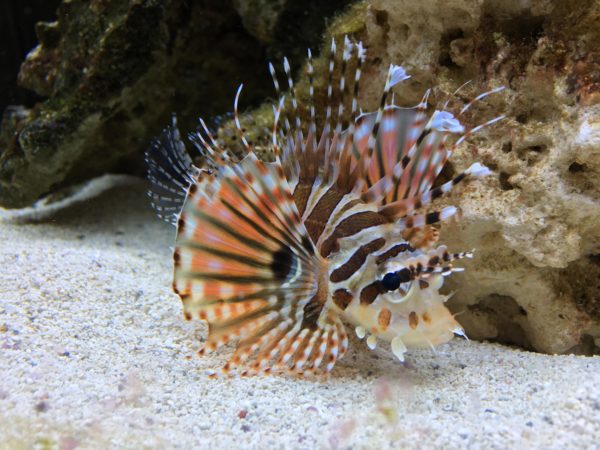
Optimum Tank Size For Dwarf Lionfish
The recommended tank size for dwarf Lionfish is 29-gallon
You can get by with a tank that holds only 50 gallons of water. They’ll require a minimum of 120 gallons of water. Even though the Dwarf Lionfish is a lonely organism that rarely swims, it requires enough swimming room to satisfy its inquisitive inclination in the vicinity of the rock formations and the cavern structure.
A Dwarf Lionfish’s typical tank size is 50 gallons. However, if you think you’ll be able to accommodate a larger aquarium, 75 gallons would suffice.
Tank Shape for Dwarf Lionfish
Tank shape required for dwarf lionfish should be “peninsula” style tank with proper rockwork and three viewable spaces.
Filter Type
A decent size skimmer is snough for as main filter. They’ll catch up large particles before tey break down into smaller nutrients. Filtrations must keep-up with the ammonia spikes.
Substrate
The fish prefers to stay at the bottom. However, that doesn’t mean it’s picky about the kind of surface it prefers because it originates from the rocky habitat with some reef or coral beds mimicking its wild environment. Place crevice-like forms around the area, and the fish will quickly make it their home.
Water Parameters For Dwarf Lionfish
Water Temperature
These fishes can survive at 22.7 to 28.8 degrees Celsius.
Water Flow Rate
Swarf don’t necessarily have to be pushed to go to places. Hence there need not to be any specific water flow rate.
pH Level
To keep the fish happy, keep the pH between 8.1 and 8.4.
Water Hardness
Water should have 0ppm Ammonia, 0ppm nitrites and 0-20ppm nitrates.
Dwarf Lionfish Tank Landscape
For a detailed look at setting up the tank for the Dwarf Lionfish, please keep reading further:
Don’t overdo the lighting in your aquarium; rather, subdued lighting is better for the fish since very strong lighting causes stress.
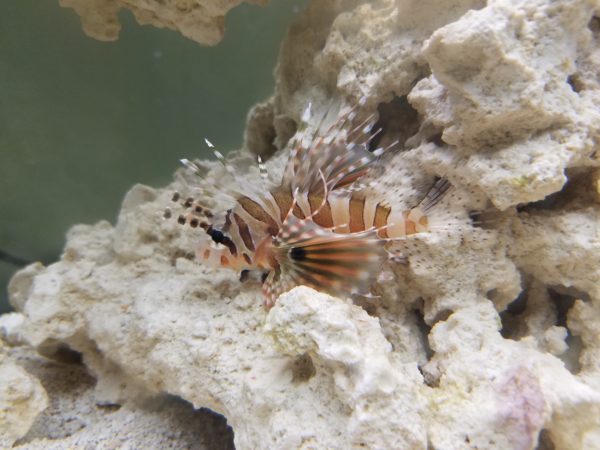
The aquarium you can house the fish needs not to be very large because it is not an active swimmer and doesn’t require much room to swim around. Therefore moderate to a small aquarium can do.
The minimum tank capacity suitable for this fish is at least 150 liters for a single adult fish.
Ensure good water quality for this fish; otherwise, it eventually stops feeding and dies. The pH range must be between 8.1 and 8.4.
The ideal tank temperature is to mimic the animal’s habitat as much as possible. For example, setting the tank at an even range between 74 and 82 degrees Fahrenheit would work well.
It is best to make the tank feel safe and secure for your fish as much as possible because it will refuse to feed if it feels threatened.
Nitrogen/Other Nutrient Requirements For Dwarf Lionfish Tank?
Ammonia and nitrite levels should be 0 ppm, although nitrate levels can range from 0 to 20 ppm. The tank must be well-filtered and ventilated.
Feeding Dwarf Lionfish
Feeding the Dwarf Lionfish should not be a big hustle because it is a predatory fish that feeds on small sea crustaceans and small invertebrates. With the appetite the Dwarf Lionfish contains, this could be a daunting and expensive task.
This fish eats live brine shrimp and small crabs in captivity. While the fish is not a very active swimmer, it will readily eat invertebrates heading its way. Another consideration is they will eat anything that fits into their mouth. This includes your other expensive fish and ornamental invertebrates.
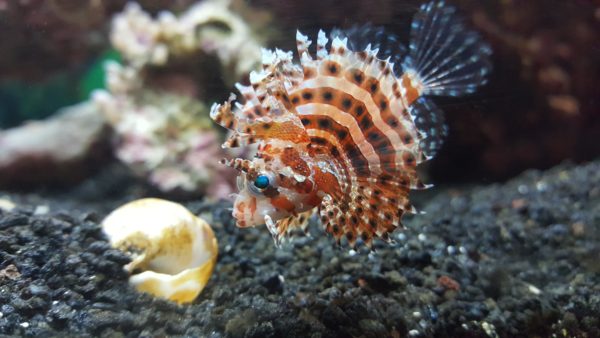
Because the fish is relatively too picky with the foods offered, it is best to have live shrimp ready with you to feed it during its first days in the aquarium.
It takes a long for the fish to accept frozen meaty foods; hence as the new owner, be extra patient with it.
Dwarf lionfish can capture and eat any living creature, even if it is predatory.
When they open their mouths, their little bodies deceive them as the large teeth they possess are capable of devouring much larger prey. As a result, they will eat anything that fits into their mouths. When caring for one of these fish in your house, feed it live foods for the first month, as they need time to acclimate to frozen meals. In order to get your fish to come out and eat, you must provide food at a certain level visible to them at the bottom of the aquarium; otherwise, they will hide in the caves and not eat.
However, using some of the procedures listed below, introduce the fish to frozen things. You can starve the fish for a while (though we don’t encourage it, just make sure it doesn’t die or get sick). Then arrange some meaty products on a tray and slowly lower the tray, or whatever you’ll be placing the food on, to the surface. You can put the food in front of a fish from time to time, convincing them that it is live prey. This fish will detect and come to feed, eventually recognizing this as a possible food source.
Because they don’t get to eat daily in their natural habitat, you can feed your glutton fish on alternate days to keep them from becoming obese.
Standard reef parameters will suit the Dwarf Lionfish just fine. They have a great personality, and while eating prepared foods, they will anxiously follow you at the front of the aquarium, waiting for their next meal.
Because venomous fish can cause severe skin rashes, never put your hands in an aquarium without wearing gloves or a protective cover.
Best Diet For Dwarf Lionfish
Dwarf Lionfishes eat a variety of foods, including
- Lobster tails
- Squids
- Shrimps
- Small crabs as well as other crustaceans.
How Often Should You Feed You Dwarf Lionfish?
The Dwarf Lionfish should typically be fed every 3 days a week.
Dwarf Lionfish Behaviour And Temperament
Dwarf Lionfish prefer to hide in crevices, camouflaging themselves beneath the sea’s sandy or rocky substrate. They are not good swimmers at all, but crawlers or even “walkers,” if that is a term that can be applied. This is because they require this disguise to be undetectable to their possible prey. Rather than chasing, they prefer to catch smaller victims off guard by surprising them.
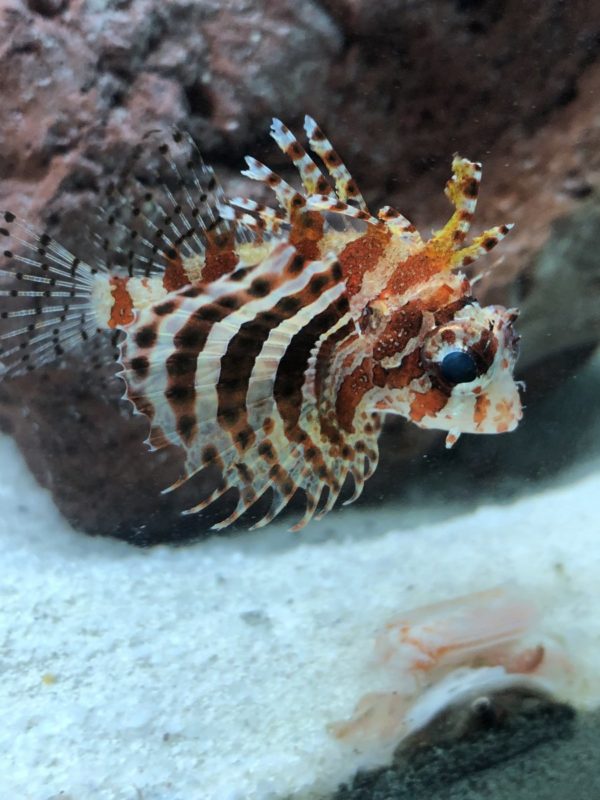
Another condition in which most of these fish seek refuge is seclusion. In the wild, they are essentially solitary but not territorial. They can, however, learn to coexist with other fish in the aquarium.
Their pleasant attitude hides that they are powerful ambush predators in a domestic setting. They are also highly resilient regarding health, and the fishes’ ability to feed is quite incredible.
Are Dwarf Lionfish One Or Societal In Nature?
Yes, numerous lionfish can be kept in the very same tank. Bigger lionfish is going to eat new, much smaller lionfish, however, if you keep all of your lionfish at the same size at first and let them grow together, they won’t view each other as food, but if you introduce a new one, it will consume its food.
Dwarf Lionfish Tank Mates
These fish are quite content to be alone. However, because they are inactive most of the time, combining them with other fish is an obvious decision from an owner’s perspective, and herein lies the catch. It’s difficult to identify fish identical to them because of their unusual temperament, which could make them both violent and bashful.
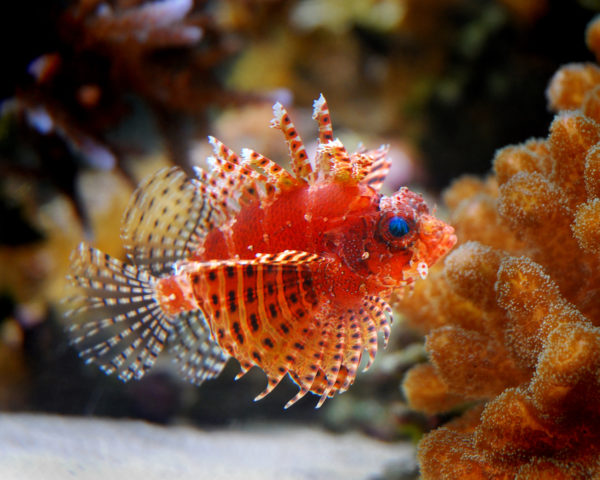
Ideal Dwarf Lionfish Tank Mates
Dwarf Lionfish should be paired with larger tankmates that will not eat them. However, larger fish, such as Moray Eels, may assault the Lionfish in retaliation. As a result, it’s typically preferable to leave Lionfish alone. They become violent even with their kind of species, and fighting can result in injuries. A male Dwarf Lionfish, on the other hand, can live in a harem of five to six females of his species.
Bad Tank Mates For Dwarf Lionfish
Almost every species is undesirable for a Dwarf Lionfish since its smaller partner fishes will either be victims of its voracious eating or become prey for larger species.
A few examples are provided below.
- Rabbitfish
- Pufferfish
- Moray Eels
- Small invertebrates and crustaceans such as crabs and shrimps
Breeding Dwarf Lionfish
New breeders will struggle with the difficult-to-breed Dwarf Lionfish. However, spawning is feasible, and when the breeding season approaches, the male begins hunting for females. On their bellies and gills, the latter has pale colors. Fertilization begins when the female begins to carry eggs and expresses an interest in a specific male. The eggs are mucus-coated and have a gelatin-like feel. It takes about 36 hours for the eggs to hatch.
The most difficult part of rearing the Dwarf Lionfish in captivity is getting it to breed, and many aquarists have had difficulty achieving this. It’s not right to claim that it fails to spawn in captivity completely. Several experienced aquarists successfully initiated their egg fertilization process by placing the male and female fishes in groups in the same tank.
However, you must note that the egg fertilization process is something that novices might not successfully achieve in the first go. But to initiate the fish’s spawning, the dwarf lionfish must be kept in a separate tank. However, you will enjoy the beauty and the breeding problems of this fish when you introduce it to your home aquarium.
Dwarf Lionfish Breeding Level – Intermediate
Dwarf Lionfish Sexual Dimorphism?
Females have a smaller head with a more sloping top. The male’s pectoral fins will be longer, reaching past the caudal peduncle, the region between the tail and the body. The male is going to appear broader and larger in general.
Dwarf Lionfish Common Diseases And Their Treatment
These fish are normally well-behaved and do not get ill quickly. That should not, however, be taken for granted. Keep an eye out for any unusual symptoms, such as losing appetite, strange sleeping habits, or restlessness. If your Dwarf Lionfish exhibits any of these symptoms, consult a veterinarian.
Facts About Dwarf Lionfish
- The pectoral fins of the Dwarf Lionfish are big and have conspicuous spotted bands.
- On the head and lateral line, a small tentacle is normally just above the eye and variously developed leafy appendages.
- The 13 poisonous dorsal spines are almost the same length as the maximal body depth or slightly shorter.
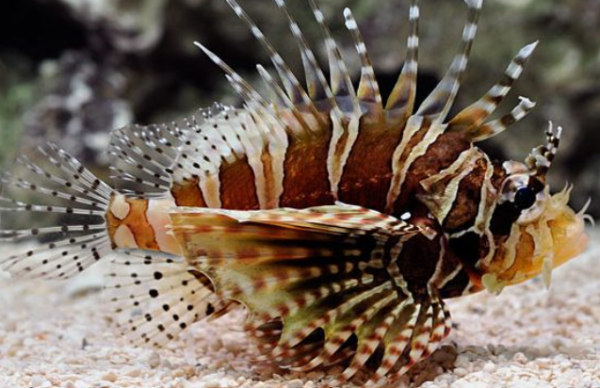
Do Dwarf Lionfish Have Poison?
The Dwarf Lionfish is a deadly fish. They are members of the scorpionfish family, named after the poisonous spines on their anal, dorsal, and pelvic spines. The spines connect to the fish’s venom sac. The venom is injected into the flesh of all other organisms via a groove in the spines. Primarily a nocturnal hunter, this fish calmly rests under the reef overhangs under the caves.
People who have been bitten by the spines described the pain as being similar to a bee sting. The pain could be short-lived or last for more than 24 hours. Some people say the agony is modest to ‘beyond measure,’ which worsens by the minute. They do possess poison injected through their dorsal spines, so NEVER put your hands around them even AFTER they are dead. It is a completely involuntary sting which means the fish does not need to be angered to release the toxins.
Swelling and, of course, excruciating pain are common lionfish sting effects. Nausea, shortness of breath, vomiting, discomfort in the stomach, and sometimes even loss of consciousness are more serious symptoms. There have been a few examples of humans dying due to lionfish stings.
The lionfish’s size directly relates to the degree of discomfort and its symptoms. Since they can inject much larger amounts of venom, a larger species can inflict much more severe injury. In either case, owners should handle dwarf lionfish with caution.
Small Buying Guide
Dwarf Lionfish are available for purchase online from major pet stores in your area and internet sites and forums. You can also seek advice from professional aquarists for healthy stock.
Before acquiring the Lionfish, consider:
Could you double-check that they’re still active?
Have insatiable appetites.
- Exhibit their distinctive brilliant colors.
- Show out all of their fins & rays, as indicated previously.
To prevent parasites and diseases from spreading, quarantine your Dwarf Lionfish in a separate tank for a few weeks before reintroducing them to the main tank.
Are Dwarf Lionfish Right For You?
Dwarf lionfish can be kept in smaller aquariums than their larger Scorpionidae cousins. This is due to their size and the fact that they are less aggressive swimmers. They do, however, require a significant amount of space and are not appropriate for nano aquariums.
FAQ
When It Comes To Dwarf Lionfish, How Long Can They Go Without Eating?
This fish is capable of going for 2 weeks without eating. Weening it to frozen foods by using live foods. Avoid starving them for a longer time period, as this may lead to their death.
What Is The Best Way To Feed Dwarf Lionfish?
If you have a lionfish that is hesitant to eat, the quickest technique to get them to accept prepared foods is to utilize feeder fish and live shrimp. Grass shrimp and ghost shrimp are two examples of fresh, live meals. Because the dwarf lionfish can easily eat live shrimps as they’re easily digested, it is preferred.
Is The Reef Safe For Dwarf Lionfish?
Lionfish can be kept in reef-only aquariums. Make sure to choose larger invertebrates. The 6′′ lionfish will devour shrimp and other invertebrates in bite-sized pieces, so most aquarists avoid keeping them in a reef tank.
Conclusion
The Dwarf Lionfish genus includes some magnificent-looking fishes. The saltwater fish has a plethora of fascinating natural characteristics and variants.
Their requirements, care, and behaviors are similar (based on the species). The poisonous Dwarf Lionfishes are not particularly energetic or agile, and they spend much of their time at the bottom of the ocean. They are most active at dawn and dusk, and these are their normal routines. A single fish in captivity can alter its inborn behavior depending on its treatment. Except during breeding season, the fish are calm and pleased with themselves, and they don’t require any company.
No related posts.
